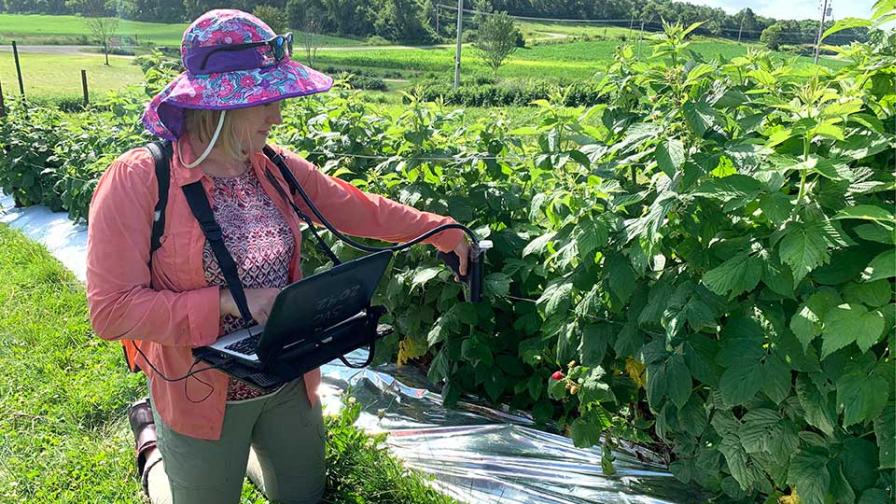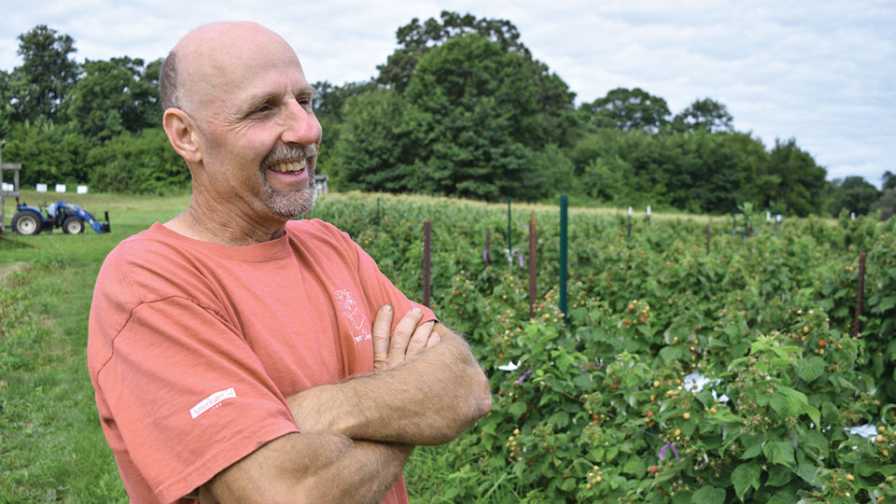Plastic Mulches Prove Effective Against Spotted Wing Drosophila in Raspberry Crops

Hanna McIntosh, a Ph.D. student at University of Wisconsin-Madison, employs a spectrometer to measure the full spectrum of light, gathering data on all the wavelengths produced by the various plastic mulches.
Photo by David Tenenbaum
The initial results are in on a University of Wisconsin-Madison study using mulches to limit spotted wing drosophila (SWD) populations in raspberries, and the results look extremely promising, as the number of larvae found in the fruit was cut by at least half.
Hanna McIntosh, a Ph.D. student at University of Wisconsin-Madison, says that over two years of study, all three plastic mulches — black, white, and metallic — reduced the number of female flies in the canopy by 42% to 51% and the number of larvae in the fruit by 52% to 71%. She said she and the project principal investigators, Dr. Christelle Guédot and Dr. Amaya Atucha, were pleasantly surprised by the results.
“At the beginning of the project, a lot of people said it wouldn’t work,” she says. “Usually, these practices don’t confer this big of a reduction.”
The results should be welcome news to berry growers in most of the U.S., many of whom are fed up trying to fight SWD. McIntosh says they did a survey of Wisconsin berry growers, and almost 30% reported they stopped growing a specific crop because of SWD. Many of the state’s berry growers are relatively small, she says, operating direct-market operations that can’t afford to do a lot of spraying, either because of the cost or, more likely, because of the preharvest intervals required when using many insecticides.
“They basically can’t keep up, because when you get high populations in your raspberries, you’re looking at throwing away a lot of fruit,” she says. “In some years, growers are throwing away half their fruit.”
Ed Bures can relate. He and his wife run a 40-acre fruit and vegetable farm near Barneveld, WI, that has hosted the trials over the past two years. The trial is continuing but is being moved to university property, as researchers want to capture yield data this coming season, which obviously can’t be done in a commercial berry patch.
Bures wasn’t surprised the mulches worked, simply because when the larvae normally emerge and drop onto the plastic mulch, they basically get cooked. But he was somewhat surprised at the amount of reduction, and he said he realized the mulches provided another benefit — increased yield.
“My wife and I pick all the fruit, and we didn’t measure it, but when picking we could see there was a lot of salable fruit, much more than usual,” he says. “The best was the metallic (mulch), then black, then white, then control. We are putting reflective mulch on a new raspberry patch we’re planting, and it should pay off in a lot more buckets of fruit.”

Ed Bures owns a 14-acre vegetable and fruit farm near Barneveld, Wisconsin. He’s struggling to grow raspberries in the face of spotted wing drosophila.
Photo by David Tenenbaum
All the mulches performed well, and McIntosh says that statistically speaking, the results from each are about the same. But for the record, the black and metallic mulches each reduced the number of adults in the canopy by 51%, and the white by 42%. As for the reduction in larvae in the fruit, the black was tops at 72%, followed by metallic, 61%, and white, 52%.
McIntosh says based on previous research showing that plastic mulches can modify the microclimate in the crop canopy, they expected the mechanism driving the reduction in flies would be related to changes in canopy temperature, humidity, or light. They continuously measured canopy temperature and humidity but found no differences among treatments, suggesting that this is not why flies were reduced in the mulched plots.
They also continuously measured canopy light intensity and found higher radiance in the canopy above all three plastic mulches in the UV spectrum compared to the control, and higher radiance above the white and metallic mulches in the visible spectrum compared to the control. Previous research has established that UV light is used by insects for navigation and orientation, so they will follow up on these results this year and test whether the increase in reflection of UV light by the plastic mulches is the mechanism reducing SWD adult and larval populations.
“We suspect it’s the UV light, but it’s possible there are temperature changes in the lower canopy having an effect,” she says. “We will be doing more testing.”
But one thing is for sure. McIntosh says mulches are a promising practice that can be incorporated in IPM programs and can work in both organic and conventional fields.
“It’s something we can recommend for growers in the Upper Midwest and tentatively for growers elsewhere, but it does need to be tested more broadly.”









